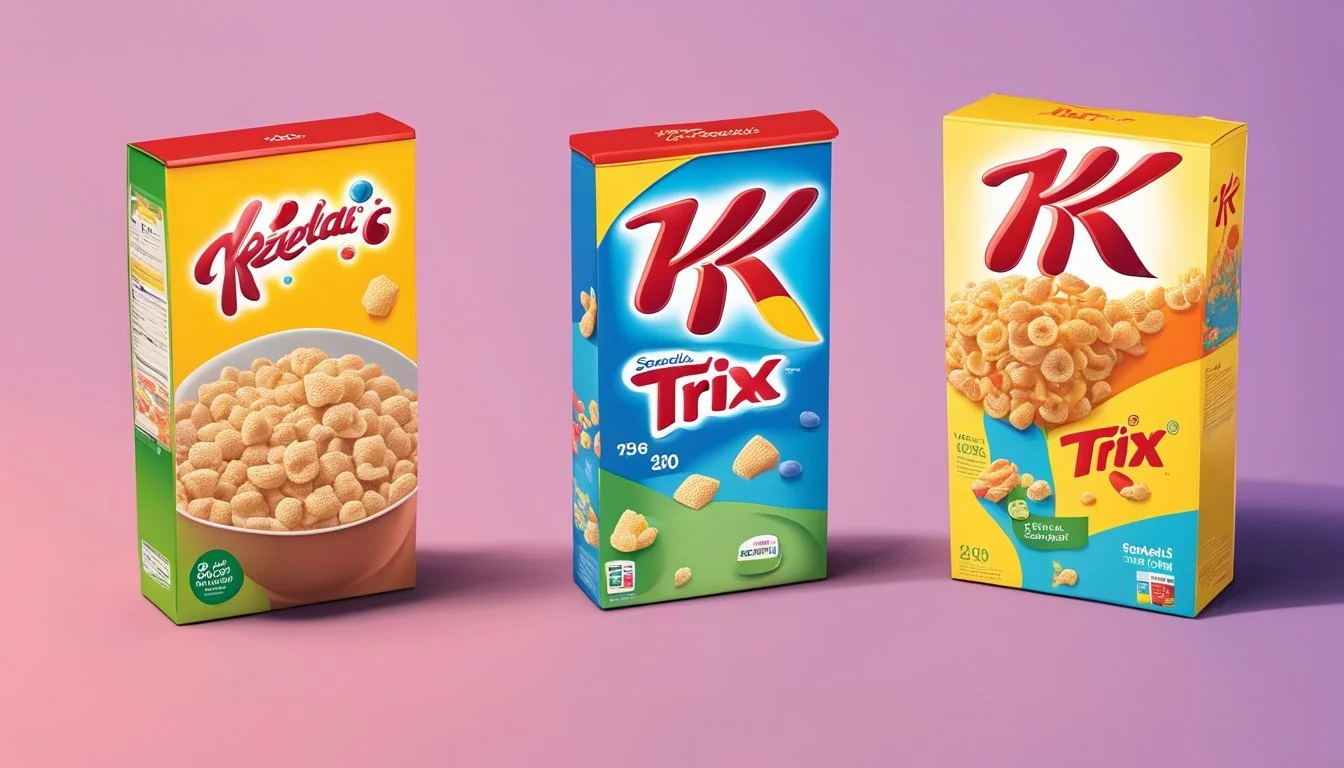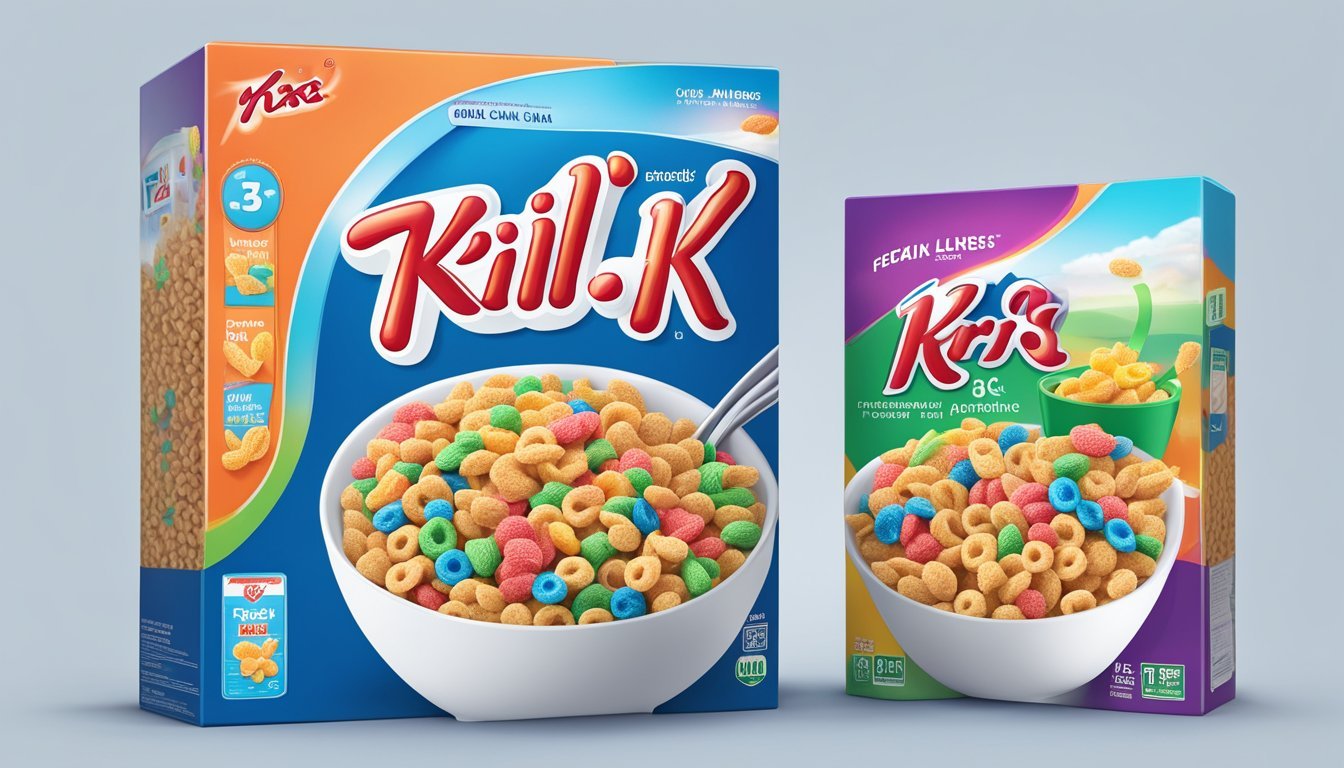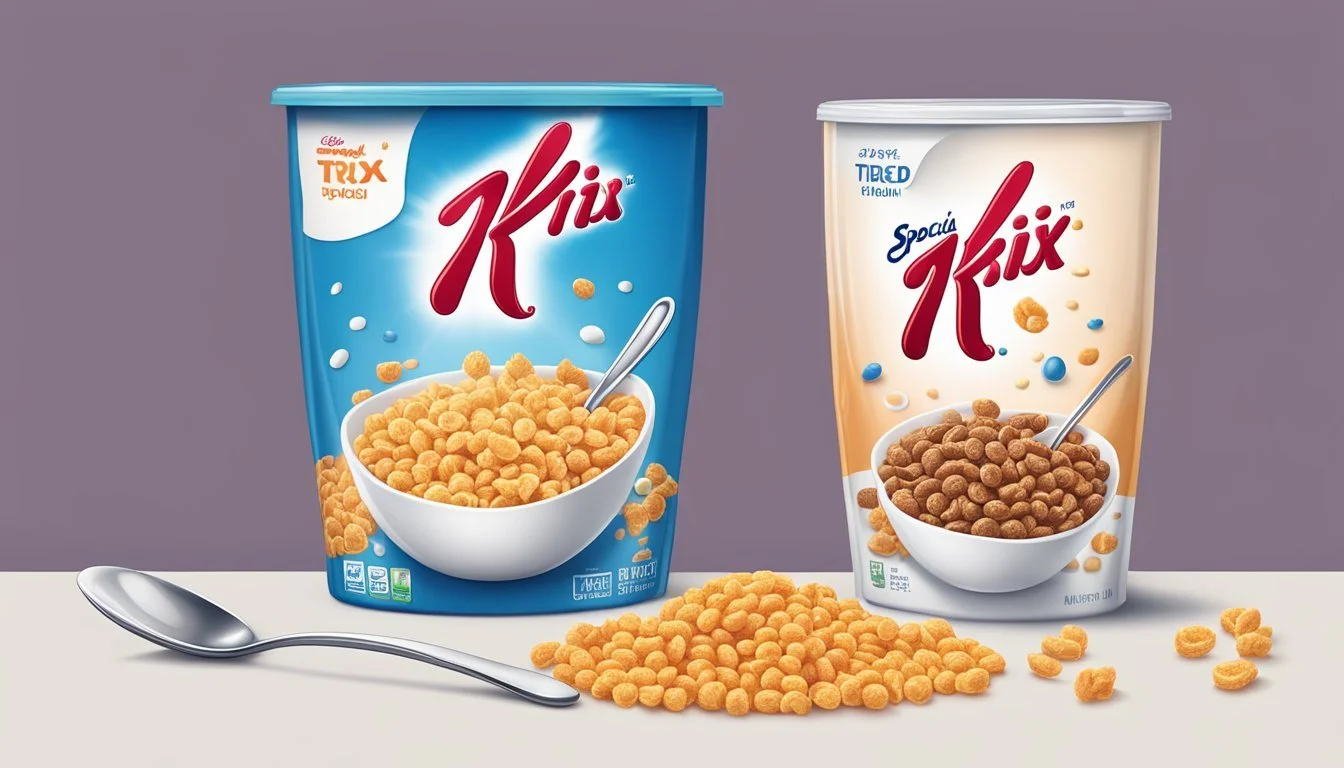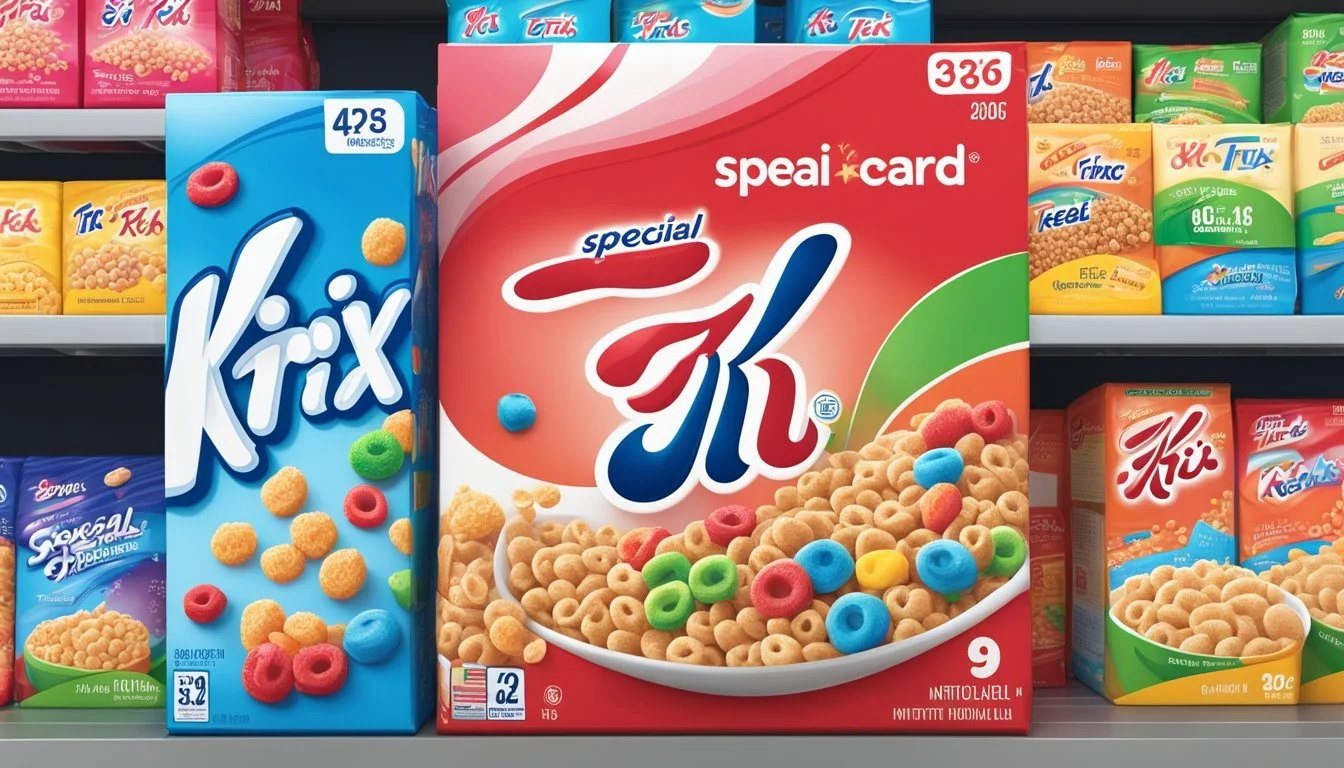Special K vs Trix
A Nutritional Comparison
This Article is Part of Our Breakfast Cereal Guide with Details on Special K Nutrition and Trix Nutrition
When it comes to choosing between Special K and Trix for a healthy breakfast, it's crucial to consider the nutritional benefits each cereal provides. Special K, made by Kellogg, stands out with its impressive content of vitamins and complex carbohydrates. It's particularly rich in Vitamin B12 and Vitamin E, making it a solid choice for those who are health-conscious.
Trix, a fun and colorful offering from General Mills, might appeal more to children or those with a sweeter tooth. While Trix has slightly fewer complex carbohydrates per serving compared to Special K, it's important to acknowledge that it contains significantly less Vitamin E. This could influence a consumer's decision based on specific dietary needs.
Overall, Special K appears to be the healthier option due to its higher vitamin content and balanced nutritional profile. Those looking for a nutrient-packed start to their day might lean towards Special K, while fans of more sugary, playful options might still prefer Trix.
Historical Context and Brand Overview
Special K and Trix have made significant marks in the cereal market, each with its unique history and evolution. Their journeys reflect broader trends in consumer preferences and marketing strategies over the decades.
Origin of Special K
Special K was introduced by Kellogg in 1955.
The cereal primarily consists of lightly toasted rice, wheat, and barley. Initially, it was marketed as a low-fat, health-conscious option for weight management.
Special K’s branding evolved to emphasize its nutritional benefits and simple ingredients. By focusing on health and wellness, it managed to carve out a niche in a market crowded with sugary options.
Promotions often highlighted its role in diet plans, making it a staple for health-conscious consumers. Throughout the years, Special K has expanded its product line to include meal bars and flavored cereal variants, maintaining relevance even with changing dietary trends.
Evolution of Trix
General Mills launched Trix in 1954.
This cereal is primarily made from corn and is known for its vibrant colors and fruity flavors. Initially targeted at children, Trix featured exciting marketing campaigns with its famous mascot, the Trix Rabbit, who became a beloved character in cereal advertising.
Over the years, Trix stayed true to its playful and colorful brand image. The cereal’s marketing campaigns often played on themes of playful mischief and fun, appealing to both kids and nostalgic adults.
In various phases, General Mills has introduced different shapes, colors, and limited-edition versions, ensuring Trix remains appealing across generations.
Nutritional Profile
Special K and Trix cereals offer varying nutritional benefits, catering to different dietary needs and preferences. Below, we compare the two cereals in terms of ingredients, nutritional value, vitamins, minerals, fiber, protein, and whole grains.
Special K Ingredients and Benefits
Special K is primarily made from rice and wheat, which are refined grains. It is known for being low in fat and cholesterol, making it a healthy choice for those watching their intake.
A single serving offers 0 grams of fat and 230 milligrams of sodium. Despite the lack of fat, Special K delivers adequate protein with 6 grams per serving, which can help maintain muscle mass. The cereal is relatively low in sugar, containing about 4 grams per serving, making it a suitable option for a lower-sugar diet.
Trix Composition and Nutritional Value
Trix cereal, produced by General Mills, is a colorful, fruity breakfast option that is particularly popular among children. Its primary ingredients include corn, sugar, and flour, making it a part of the refined grain category.
Each serving of Trix contains 1 gram of fat and 140 milligrams of sodium, making it somewhat lower in sodium compared to Special K. However, it has a notably higher sugar content at about 10 grams per serving. With only 1 gram of protein per serving, it falls short in providing the protein content that some may seek in their breakfast cereal.
Vitamins and Minerals Content
Special K is fortified with a range of vitamins and minerals. It contains 31 times more Vitamin E than Trix, delivering 15.3 mg compared to Trix's 0.5 mg.
Both cereals are fortified with essential vitamins such as Vitamin B6, B12, and C. However, Special K tends to include higher levels of iron, zinc, and calcium, contributing to its overall nutritional value. These minerals and vitamins are crucial for immune function and overall health.
Fiber, Protein, and Whole Grains
Special K has an advantage when it comes to fiber content. It includes about 1 gram of fiber per serving, which aids digestion and promotes a feeling of fullness.
In contrast, Trix provides less fiber, making it less effective for those targeting higher fiber intake. Whole grains are more prevalent in Special K, particularly in varieties that include whole wheat.
Though neither cereal is an excellent source of protein compared to other foods, Special K provides more protein per serving. This makes it a more balanced option for those looking for a healthier breakfast that supports muscle maintenance.
In summary, Special K appears to be the healthier option for those seeking lower sodium, higher fiber, and better overall nutrient density. Trix is more suitable as an occasional treat rather than a daily breakfast staple owing to its higher sugar content and lower overall nutritional benefits.
Health and Diet Considerations
When comparing Special K and Trix, several factors contribute to their impact on health and diet. These factors include caloric content, sugar and sodium levels, and allergen concerns.
Weight Management and Caloric Intake
Special K contains 110 calories per serving, which makes it a lower-calorie option compared to Trix. Trix generally has higher calories due to its sugar content.
For individuals focused on weight management, Special K may be a better choice. Lower calories can help control daily caloric intake, assisting in weight loss or maintenance goals. Additionally, consuming cereals lower in calories can provide more flexibility in overall diet planning.
Reducing Sugar and Sodium in Diets
Special K is low in simple sugars and fat, making it a healthier breakfast option. Trix, on the other hand, tends to have higher sugar levels which can contribute to an increased glycemic index and potential health risks.
Reducing sugar intake is crucial for managing blood sugar levels and overall health. Special K’s lower sugar content helps in minimizing the risk of insulin spikes. Both cereals have sodium content; however, Special K is often chosen for its balance of essential nutrients without excessive sodium.
Allergens and Food Sensitivities
Special K and Trix contain common allergens such as wheat and milk derivatives. Special K offers options that are designed with fewer additives, which can be advantageous for those with sensitivities or mild food allergies.
Individuals with gluten intolerance or specific food allergies should carefully check the ingredient labels. While neither cereal is suitable for strict gluten-free diets, choosing varieties with simpler ingredients reduces the risk of reactions.
Both cereals provide important nutrition information, and careful consideration can lead to healthier breakfast choices.
Market Position and Consumer Perception
Special K and Trix occupy distinct segments in the cereal market, each with unique brand perception and marketing strategies that influence consumer loyalty and purchasing behaviors.
Sales Data and Consumer Trends
Special K focuses on health-conscious consumers, leveraging its reputation for weight management and nutritional value. Its market positioning has shown consistent sales growth, particularly among adults who prioritize healthy eating. Special K's product line includes cereals, protein bars, and shakes, broadening its consumer base.
Trix, on the other hand, appeals primarily to children and nostalgic adults. Known for its vibrant colors and sweet taste, Trix has maintained a strong presence in the kid's cereal segment. Seasonal and limited-edition offerings help boost its sales and keep consumer interest high.
Pricing and Economic Factors
Special K is positioned as a premium product, often priced higher due to its health-oriented ingredients and brand image. This pricing strategy targets consumers willing to pay more for perceived health benefits. Discounts and promotions are strategically used to attract new customers while retaining existing ones.
Trix is generally priced lower, making it accessible to a wider audience. Its competitive pricing, coupled with frequent discounts, appeals to budget-conscious families. The economic approach ensures that Trix remains an affordable option in a market segment where price sensitivity is high.
Target Demographics and Branding
Special K targets adults, especially women, who are interested in health, fitness, and wellness. The brand uses marketing campaigns that highlight transformation and empowerment, resonating with an audience looking for healthy lifestyle choices. Packaging and advertising emphasize nutritional benefits and weight management.
Trix's branding is colorful and playful, designed to attract children. Mascots and fun advertising hook young consumers, while nostalgia-themed campaigns appeal to parents who grew up with Trix. This dual approach strengthens its market position across different age groups. Its branding is centered around fun and excitement, making meals an enjoyable experience for kids.
Practical Information
This section provides essential details about serving sizes, product variants, flavors, and storage tips for Special K and Trix cereals.
Serving Sizes and Portions
Special K recommends a serving size of 1 cup (31 grams), while Trix specifies a serving size of 1 cup (32 grams).
Special K tends to be used as a breakfast option or a snack, making it versatile.
Due to their varied caloric contents, understanding the serving sizes helps in portion control. Special K offers fewer calories per serving (around 120 calories) compared to Trix, which has around 130 calories.
Product Variants and Flavors
Special K offers a diverse range of flavors, including Original, Red Berries, Vanilla Almond, Chocolate Delight, and more.
These variants cater to different taste preferences, making it an attractive choice for various consumers.
Trix is known for its colorful and fruity flavors, such as Classic with Fruity Shapes, Berry Berry, and Wildberry Red Swirls. Both brands periodically introduce limited-edition versions.
Proper Storage and Freshness
Proper storage is essential to maintain the freshness and crunch of both cereals. Store Special K and Trix in a cool, dry place, ideally within an airtight container after opening to prevent exposure to moisture and pests.
Trix typically has a shelf life of 9 months, while Special K can last up to a year if stored correctly.
Purchase smaller packages if you consume cereal infrequently to maintain freshness over time.
Comparative Analysis
Special K and Trix offer distinct nutritional profiles, which can appeal to different consumer preferences. This analysis will cover their direct comparison, explore alternatives from competing brands, and delve into taste profiles and consumer reactions.
Direct Comparison: Special K vs. Trix
Special K is recognized for its higher levels of essential vitamins, notably Vitamin B12 and Vitamin E.
Cereal Complex Carbohydrates (per serving) Vitamin B12 (%) Vitamin E (mg) Special K 16.0 grams 613% 15.3 mg Trix 13.0 grams - 0.5 mg
Trix contains fewer complex carbohydrates compared to Special K. Special K offers a significant boost in vitamins, which makes it appealing to health-conscious individuals. Trix, on the other hand, may have a higher sugar content, making it a favorite among children.
Competing Brands and Alternatives
In addition to Special K and Trix, several other cereals offer varied nutritional benefits.
Cheerios is known for its heart health benefits and low sugar content. Rice Krispies and Corn Chex offer lower calories and are often touted for their simple ingredients.
Cocoa Puffs and Cookie Crisp provide more sugar and less nutritional value, targeting younger audiences.
Fruity cereals like Honey Smacks and Fruity Pebbles compete with Trix in terms of flavor but might fall short nutritionally compared to Special K. Lucky Charms adds marshmallows, appealing to those seeking a fun, sweet experience.
Taste Profiles and Consumer Preferences
Taste is a critical factor that influences consumer preferences.
Special K is often described as having a neutral, slightly nutty flavor, appreciated by adults looking for a healthier choice. Trix is vibrant and fruity, popular among children who enjoy sweet, colorful breakfasts.
Consumer preferences tend to align with the target audience’s age and dietary considerations. Adults may prefer Special K or Cheerios for their health benefits. Children might lean towards Trix or Lucky Charms for their exciting flavors and shapes.
This segmentation ensures that various brands meet diverse needs, from nutritional value to taste appeal, shaping consumer choices at the breakfast table.








